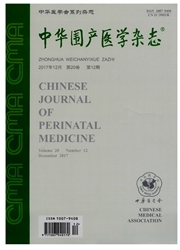

 中文摘要:
中文摘要:
目的探讨缺氧诱导丝裂原因子(hypoxia-induced mitogenic factor,HIMF)对胎肺形态发育及表面活性蛋白B(surfactant proteinB,SP-B)、表面活性蛋白C(surfactant proteinC,SP-C)表达的调控作用。方法体外分离、培养小鼠第13.5天胎肺组织,分为HIMF处理组:在培养基中添加重组HIMF蛋白,终浓度为100nmol/L;对照组培养基中不加任何处理。分别在培养0、48、72h后,每组每时间点选取20例胎肺采用倒置显微镜和HE染色观察胎肺形态学和组织学的改变,采用Western印迹、免疫组化、实时逆转录-聚合酶链反应技术检测胎肺组织中SP-B和SP-C的蛋白、mRNA表达水平变化。结果HIMF处理组培养48、72h后,肺泡数目分别为(14.37±0.85)和(18.41±1.24)个/高倍视野,肺泡分支的数目分别为(2.51±0.35)和(3.28±0.51)个/高倍视野,均较对照组相应时间点[分别为(8.09±0.92)、(9.54±0.78)、(1.45±0.32)和(1.69±0.43)个/高倍视野]增加,差异有统计学意义(P〈0.05)。对照组胎肺体外培养72h后,SP—B、SP—C蛋白表达较少,染色强度弱,主要定位于Ⅱ型肺泡上皮细胞;HIMF处理组可见Ⅱ型肺泡上皮细胞内SP-B、SP-C弥漫表达,以靠近肺组织边缘为甚。HIMF处理组培养48和72h后,胎肺组织中SP-B、SP-C蛋白和mRNA水平均较对照组相应时间点增加,差异有统计学意义(P〈0.05)。结论HIMF可能通过上调胚胎组织中SP-B和SP-C的表达,促进胎肺形态发育,为进一步研究HIMF在胚胎肺泡发育和成熟中的作用奠定了基础。
 英文摘要:
英文摘要:
Objective To explore the regulatory effects of hypoxia-induced mitogenic factor (HIMF) on lung morphogenesis and expression of surfactant protein B (SP-B) and surfactant protein C (SP-C) in embryonic lungs of mouse. Methods The mouse lungs at embryonic day 13.5 were separated and cultured in vitro, and divided into HIMF treatment group with final concentration as 100 nmol/L and control group with no HIMF. After incubation for 0, 48 and 72 hours, cultured embryonic lungs from each group were harvested for HE staining-mediated morphological observation. The changes of SP-B and SP-C expression in embryonic lungs were explored by western blot, immunohistochemical staining and real-time RT-PCR. Resells Administration of HIMF for 48 and 72 hours, morphogenesis were (14.37±0.85)and(18. 41± 1.24)/HP, and branching of the buds were (2.51±0. 35) and (3.28±0. 51)/HP, higher than those at the relative time points in control group, which were (8. 09±0.92) ,(9.54±0.78) ,(1.45±0.32) and (1.69±0. 43)/HP, respectively (P〈0.05). In control embryonic lungs cultured for 72 hours, the expression of SP-B and SP-C was reduced, mainly locating at type Ⅱ lung epithelial cells. Within the HIMF-treated embryonic lungs, there were intensive and diffuse expression of SP-B and SP-C, mainly around the edge of lung tissues. Compared with controls, the levels of SP-B protein and rnRNA, SP-C protein and rnRNA within HIMF-treated embryonic lungs for 48 and 72 hours were increased (P〈0.05). Conclusions HIMF may promote lung morphogenesis via enhancing the expression of SP-B and SP-C in cultured embryonic lungs, which establishes a basis for further studying the roles of HIMF in lung alveolar development and maturation.
 同期刊论文项目
同期刊论文项目
 同项目期刊论文
同项目期刊论文
 Expression of resistin-like molecule beta in Barrett’ s esophagus: a novel biomarker for metaplastic
Expression of resistin-like molecule beta in Barrett’ s esophagus: a novel biomarker for metaplastic Hypoxia-induced mitogenic factor is downregulated in nitrofen-induced hypoplastic lungs of congenita
Hypoxia-induced mitogenic factor is downregulated in nitrofen-induced hypoplastic lungs of congenita Upregulation of hypoxia-induced mitogenic factor in hyperoxia-induced bronchopulmonary dysplasia mod
Upregulation of hypoxia-induced mitogenic factor in hyperoxia-induced bronchopulmonary dysplasia mod Enhanced expression of resistin-like molecule beta in human colon cancer and its clinical significan
Enhanced expression of resistin-like molecule beta in human colon cancer and its clinical significan 期刊信息
期刊信息
